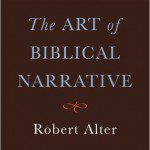
A retired pastor complimented me on my preaching yesterday. He expressed amazement at my approach, particularly how I draw out threads that hold apparently disparate things together in the texts I preach from.
This is something I think about a lot. And it is one of the things that I listen for in the preaching of others. But I seldom hear it. And I wonder, how do people miss them? It’s not really all that difficult, in my opinion. These threads often seem like they’re dyed in neon to me. I can’t help but see them.
I think there are a few things that can blind readers to them. Here’s a list. I’ll begin with the mundane and then try to dig a little deeper.
Chapter and verse
Guess what, the Apostle John didn’t number his sentences. He didn’t even break things up into chapters. And neither did any of the other writers of the Bible. Chapter and verse is helpful for finding your place, and for copying the Bible by hand. And those topical headings you find in modern Bibles? those weren’t there the originals either.
Narrative threads can run between paragraphs (another addition, by the way) as well as chapters. Chapters, verses, paragraphs, and headings in bold type, they’re all a bit misleading. They reflect someone’s attempt to organize the text. And that amounts to interpretation.
Pericopes
These are discrete units within the larger text that are often set apart from each other by a resolution of a story or a change in the setting, particularly in the Gospels. Because you can lift them out without apparent violence, you can miss how pericopes often connect, and even build on each other. Think pointillism, just because you can see a point doesn’t mean that you’ve gotten the whole point. Perhaps the point is just one point in a larger image. It often is.
Reductionism
There is a tendency in modernity to break things down to their simplest parts. The belief is that by knowing the parts you can add them up to a full whole. Word-study guys think this way. They can spend a whole month of sermons on a sentence, taking you into the original language, maybe take you into the ways words are used in other parts of the Bible, or maybe even in contemporaneous extra-biblical texts.
This is the old missing the forest for the trees problem. Many things really are more than the sum of their parts.
Ignorance
I think most interpreters miss narrative threads simply because they don’t know to look for them. Once you know they’re there for the finding, finding them is not all that hard to do.
I think this could be due to two things.
First, we have a bias for simplicity. We like things that can be found on the surface, almost without ability. Ability is so elitist. Some people have more of it than others. Narrative threads can be subtle, even thin at times to the neophyte, calling for good judgment and practiced handling to identify.
Second, most preachers these days are absolutely artless. They’re trained to be grammar nerds, not writers or story-tellers. Writing is a craft, and the more you do it, the better you get at seeing what other writers are doing in their writing. (As an aside, this is why so many modern translations fail. Most Bible translators are grammar nerds, not writers.)
Knowledge
Finally, there’s no surer way to remain ignorant than by knowing something. Perhaps a text is so familiar its hackneyed interpretation intrudes upon the mind when it is read. Or perhaps you’re the sort of person who tends to use the Bible to proof-text doctrine. In that case, once the text has proved a doctrine, its work is done. No further thought is required.
But a text can prove a doctrine and still have more to say. To hear the more you may need to put what you know aside for a moment. In my experience this has a way of enriching your understanding of doctrine as well as the text.
What does all this look like in practice? Next time I’ll look at some passages from Mark to show you how I go about it.












